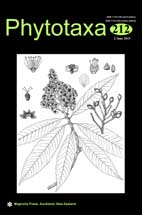Abstract
Nine plants specimens of an apparently new Tridactyle species were collected in Gabon and Equatorial Guinea. They have an erect habit and a particular leaf shape which makes the species unique in the genus. The flowers and inflorescences share the general morphology of Tridactyle tridactylites, one of the most frequently collected species of Tridactyle in Central Africa. Four other Tridactyle taxa possess a 3 to 6 cm long inflorescence and a labellum with entire side lobes, and one species, Tridactyle stevartiana, has leaves of similar width and length. We here show that these new 9 specimens represent a new species, described as Tridactyle minutifolia. The diagnostic traits include linear thin leaves, and erect habit. Interestingly, many specimens of Tridactyle minutifolia lack spur; this phenomenon is sometimes found in orchids growing in an environment where their pollinators are absent. A table of the diagnostic characters of the six Continental African Tridactyle taxa considered here is included. A preliminary assessment of the conservation status of T. minutifolia, using the IUCN Red List Categories and Criteria is provided.

